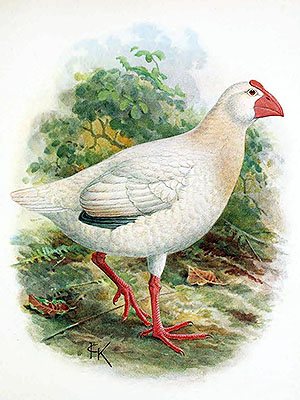New Caledonian Swamphen (Porphyrio kukwiedei)
The New Caledonian Swamphen was described in 1989 based on subfossil bones that were excavated from deposits from the Pindai Cave complex on the western coast of Grande Terre, New Caledonia.
The species was about the same size as the New Zealand Takahe (Porphyrio hochstetteri (A. B. Meyer)) but was more lightly built, it was likewise flightless, the males probably were larger then the females. [2]
The New Caledonian Swamphen may in fact have survived into quite recent times, this can be assumed from a note that is given at the description of another New Caledonian bird species, the now likewise extinct New Caledonian Rail (Gallirallus lafresnayanus Verreaux & Des Murs).:
“Nouvelle-Calédonie, où il est nommé, par les indigènes, N’dino, camp de Morari. It vit dans les lieux marécageux, et arriverait, dit la note, a la taille du Dindon! Est-ce la même espèce, ou bien y en aurait-il une autre qui atteindrait cette dimension?” [1]
translation:
“New Caledonia, where he is named, by the natives, N’dino, camp of Morari. It lives in marshy places, and would arrive, says the note, the size of the turkey! Is it the same species, or would there be another one that would reach this dimension?“
This description, in my opinion, fits better with the far larger New Caledonian Swamphen than with the New Caledonian Rail.
There is furthermore an account that speaks about old people who remember a bird that was similar to the Australasian Swamphen (Porphyrio melanotus (Temminck)), that still is commonly found in New Caledonia, except for being much larger and having a grey tail and a white throat. Unfortunately I do not find the source for that statement anymore.
*********************
References:
[1] M. M. Jules Verreaux; O des Murs: Description d’Oiseux nouveaux de la Nouvelle-Calédonie et indication des espèces déjà connues de ce pays. Revue et Magasin de Zoologie pure et appliquée. Ser. II 12: 431-443. 1860
[2] J. C. Balouet; Storrs L. Olson: Fossil birds from Late Quaternary deposits in New Caledonia. Smithsonian Contributions to Zoology 469: 23-27. 1989
*********************
edited: 16.05.2019

